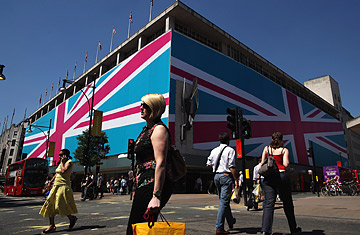
LONDON, ENGLAND - JULY 24: Members of the public walk past the John Lewis department store, where a giant Union Flag adorns it's facades, on Oxford Street on July 24, 2012 in London, England. London is gearing up with only 3 days remaining until the opening ceremony of the 2012 London Olympic games.
In Britain, big department stores tend to be as concerned about pedigree as the country's consumers. Ultra-posh stores like Harrods and Harvey Nichols cater to luxury lovers, while dowdier chains like BHS serve the budget-minded. But John Lewis, the country's largest and most successful department store, has become a national institution by doing both. At the 148-year-old chain, which has 29 department stores and eight smaller home stores around the country, members of the 1% drooling over $6,200 Maurice Lacroix crocodile-leather watches commingle with value shoppers angling for $31 unisex plastic Casios. Imagine wrapping a Bloomingdale's, Macy's and J.C. Penney into...

